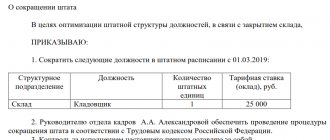In 2011-2013 Government positions are planned to be cut by approximately 20%, gradually over three years. In 2011 and 2012, 5% of employees have already been laid off, and in 2013, civil servants will face the largest reduction - 10%.
According to the Government's plan, 50% of budget allocations freed up as a result of optimizing the number of civil servants will be used to provide material incentives for workers who remain in the service.
The reduction of positions can be carried out both through a reduction in the number of positions, and through measures to reorganize the government agency or change its structure (revision of the staffing table or staff, statutory documents, etc.).
Employees dismissed due to a reduction in civil service positions enjoy all the guarantees, benefits and compensation provided for by current legislation. Let's take a closer look at which ones exactly.
Warning about dismissal of civil servants
The employer is obliged to notify employees in writing of dismissal due to reduction no later than 2 months in advance. This is indicated by part four of Article 31 of the Federal Law of July 27, 2004 No. 79-FZ “On the State Civil Service of the Russian Federation” (hereinafter referred to as Law No. 79-FZ).
Dismissal of a civil servant can be carried out without a two-month notice period only with the written consent of the employee.
Also, the employer must notify the elected trade union body of the government agency, and not just the employees themselves, about this event 2 months before the upcoming dismissal. This requirement is contained in Article 38 of Law No. 79-FZ.
Payments to reduce the number of civil servants 2020
At the same time, the legislation establishes a fairly clear procedure for notification. First, the notice must be provided in writing. Secondly, only against the signature of the employee. A person’s absence from the workplace for a valid reason is not grounds for lack of notification of an upcoming layoff.
Federal law does not exclude the case of dismissal of employees of an organization on the initiative of the manager. Staff reduction is an absolute method of optimizing activities in any enterprise. The legislation provides for cases when a mercenary occupying a liquidated position, through transfer, has the right to obtain another free position in the organization. There is a procedure for conducting staff reduction procedures that the manager must follow.
Interesting: How Many Questions Are There in Traffic Tickets 2020 Without Repetitions
Actions of the employer's representative when laying off civil servants
Having decided to reduce positions in the state civil service, the relevant authorities and representatives of employers must take into account and comply with certain provisions of regulatory legal acts.
The employer must resolve the following issues within 2 months from the date of written warning about the layoff of civil servants:
- Assess the possibility of preferential rights for workers who have been laid off to fill vacant positions in the civil service.
- Provide for the possibility of continuing further relations with this category of state civil servants.
Both of these issues can be resolved within the framework of extraordinary certification of civil servants. Law No. 79-FZ (Part 7, Article 31) gives a preferential right to fill a position to employees who have higher qualifications, longer work experience (service) in their specialty or civil service, an appropriate level of professional education and higher performance indicators of professional service activities.
Reduction
The reduction of a civil servant has several significant differences from the standard procedure due to existing legislative regulations that were introduced due to the specifics of the work.
Important! The latest version of Federal Law 79 came into force in August 2020. For example, changes were added to Article 31, which regulates relations during the liquidation or reduction of positions in a government agency. All labor relations with civil servants are carried out in accordance with Federal Laws 79 and 57. According to the regulations of the labor code, only those points that were not taken into account in the regulations of these legislative acts are reviewed.
To understand the difference between a standard reduction and a similar procedure for a civil servant, you need to know the step-by-step procedure. It is according to this plan that reductions are made in government organizations:
- notification of the employee depending on the type of reduction (in case of liquidation or reorganization - 3 months, in the rest 2 months) within the prescribed period;
Sample notice of job reduction
- notification of the trade union that regulates labor relations in the organization. This point is mandatory and is carried out at the same time as notifying employees;
- notification of all interested services and authorities;
- if there are available vacancies, the opportunity to transfer is provided in accordance with qualifications and job skills;
- a month before the actual layoff, if there are no positions in the organization, a search for jobs in similar government agencies begins;
- an extraordinary certification is carried out, which allows a number of employees to receive a preferential right to obtain a new job;
- translation is carried out in accordance with legal regulations;
- If an employee refuses the vacancies provided, then the employment contract with him is terminated within the prescribed period. Any refusal or consent must be properly executed and in writing. These documents are attached to the employee’s personal file. If there was no refusal, but the civil servant was laid off, then he has the right to appeal this decision by appealing to the court. An important point is the correct completion of the refusal or consent and the charming presence of the employee’s signature;
- On the last day of work, a settlement is made with the employee. He must also receive all the necessary documents.
Important! If an employee agrees to terminate the contract early, then he is also entitled to compensation for the unworked period of time, which is calculated according to the general rule.
It is important to remember that a civil servant can count on a vacant position based on his qualifications and experience. As with the standard option, the position must match the employee’s skills.
Read on the topic: Peculiarities of dismissal of municipal and civil servants from the civil service at their own request
Read on topic: Termination of a fixed-term service contract with a civil servant
Options for continuing the employment relationship
Law No. 79-FZ (Part 1, Article 31) provides that in the event of a reduction in civil service positions, labor relations with the employees occupying them can be continued:
- if a civil servant is given the opportunity to fill another civil service position in the same state organization, or in another government agency, taking into account his length of work (service) in his specialty or length of civil service, the civil servant’s professional education and level of qualifications;
- when sending a civil servant for advanced training or professional retraining.
There is also the possibility of civil servants replacing the positions of temporarily absent civil servants (Part 3, Article 30 of Law No. 79-FZ). In this case, a fixed-term service contract is concluded with a civil servant who has been laid off (see also letter of the Ministry of Health and Social Development of the Russian Federation No. 2956-17 dated October 1, 2008).
This kind of option is possible if the employer has positions in which some civil servants are on parental leave, are sick for a long time, are on long-term vacations without pay, etc.
It should be noted that simultaneously with the return to work of the “main” employee, the service contract concluded with the temporary employee is terminated.
Government bodies often employ not only civil servants, but also other categories of workers whose work activities are not regulated by Law No. 79-FZ. These include the so-called “technical performers”, service personnel, etc.
If a civil servant is transferred to positions not provided for in the Register of Positions of the State Civil Service of the Russian Federation, it is necessary to talk not about the transfer (transition), but about the dismissal of the employee from the civil service and the hiring of the same employee to a new position.
If a civil servant refuses to be sent for retraining, or he is not satisfied with the alternative position offered, he is dismissed from the civil service due to reduction: clause 6 of part 1 of Article 33 of Law No. 79-FZ will be the basis for dismissal.
Reduction forecasts and previous experience
The bill has been in force since 2014, according to the document. The number of government employees needs to be significantly reduced, since the state spends an excessive amount of money received from taxpayers on their maintenance.
Reorganization processes are systematically carried out in regions and regions aimed at optimizing the operation of the apparatus. The reductions will primarily affect those workers who occupy their positions without the required experience, education or qualifications, that is, citizens did not have the right to occupy this job a priori.
For this period of time, responsible and leadership positions can only be held by citizens who have received a scientific specialist or master's degree. Other workers require specialized education in the appropriate category.
Compensation upon dismissal due to reduction
A civil servant must be paid compensation equal to four months' salary if he is dismissed due to layoffs (Part 9, Article 31 of Law No. 79-FZ). Severance pay, which is provided for by the Labor Code of the Russian Federation (hereinafter referred to as the Labor Code of the Russian Federation), is not paid in this case.
The salary is also maintained during the fifth and sixth months upon dismissal due to reduction of civil servants serving in civil service in the Far North and in areas equivalent to such.
The Presidium of the Supreme Court of the Russian Federation confirmed the legality of the civil servant making this payment, provided for in part two of Article 318 of the Labor Code of the Russian Federation. In this case, we are also talking about payment of compensation in the amount of salary for the 5th and 6th months from the date of dismissal, and not about severance pay.
The procedure for calculating compensation is specified in the relevant local regulations. In relation to federal state civil servants, payments are calculated in accordance with Decree of the Government of the Russian Federation dated September 6, 2007 No. 562. This document approved the Rules for calculating the salary of federal state civil servants (hereinafter referred to as the Rules).
The calculation of the monthly salary of civil servants in accordance with clause 8 of the Rules consists of:
- from the monetary salary established on the date of termination of the service contract (salary for class rank and official salary), monthly bonus for special conditions of civil service, monthly bonus for length of service, bonus for working with information constituting state secrets, as well as from monthly monetary incentives;
- from one twelfth of the amount of bonuses for completing particularly important and complex tasks, financial assistance and a lump sum payment for vacation, accrued in fact during the 12 calendar months preceding the date of termination of the service contract.
Procedure for dismissal of a government department employee
As soon as senior management makes a decision to cut staff, the employer gives instructions to issue an internal order according to the structure. The personnel employee is obliged to correctly register the order, according to the established internal standards of the institution. An employee of the personnel department is obliged to officially notify specific employees included in the list of layoffs that their vacancy is planned to be reduced in two months.
Important! The employee is obliged to leave his signature in the document of the relevant order. In addition, the layoff notice sets the exact date of the last working day of each laid-off employee.
Signature and date are required. With their help, the employer subsequently has the right to prove the fact of notifying the employee, which is regulated by the current Federal Legislative Code. Labor legislation does not require this procedure, so there is no need to look for such a provision there.
An example of calculating compensation when laying off a civil servant
Let us assume that a civil servant, who is a 3rd class adviser to the state civil service of the Russian Federation, resigns on March 1, 2013 due to a reduction in the position of the federal state civil service.
Let’s assume that his monthly allowance consists of the following payments:
- official salary – 5,419 rubles;
- salary for class rank - 1,515 rubles;
- long service bonus (10%) – 542 rubles;
- allowance for special conditions of civil service (120%) – 6,503 rubles;
- monthly cash incentive (1 salary) – 5419 rubles.
In addition, during the 12 months before dismissal (from March 2012 to February 2013), the civil servant was awarded bonuses for completing particularly complex and important tasks totaling 189,300 rubles. Also, for the 12 months preceding the layoff, the civil servant received financial assistance and a one-time payment for vacation in the total amount of 20,802 rubles.
So, in addition to the salary, the civil servant was paid 210,102 rubles (189,300 rubles + 20,802 rubles) for 12 months.
To calculate compensation upon dismissal, the monthly salary of a civil servant will be 36,906.5 rubles. (5,419 + 1,515 + 542 + 6,503 + 5,419 + (210,102 : 12 months)).
The amount of compensation upon dismissal will be 147,626 rubles. (RUB 36,906.5 * 4 months).
In relation to civil servants of the constituent entities of the Russian Federation, the relevant laws or other regulatory legal acts may provide for slightly different rules for calculating compensation.
The payment in question relates to compensation payments associated with dismissal, and therefore is not fully included in the base for calculating insurance premiums and is not subject to personal income tax.
Forgotten idea
The Ministry of Finance announced the civil service reform planned for 2020, which involves reducing the number of officials. The same Tatyana Nesterenko spoke about this, and in almost the same words. However, in the spring, apparently, one half of the media and bloggers were busy discussing the newly adopted law on fake news, while the other half watched with bated breath the chronicle of the resignation of Kazakh President Nursultan Nazarbayev. So the news slipped through almost unnoticed.
It looks even more strange that the current interview with the Deputy Minister of Finance, in which she spoke about the main parameters of the reform, was suddenly decided to be challenged by the government apparatus.
The Prime Minister's press secretary Oleg Osipov said that no final decisions have yet been made and meetings at which the “basic principles and directions of reform” will be determined have yet to take place. It seems that from March to September there was not the easiest discussion between the Ministry of Finance and the Prime Minister. And the decision to publicly remind about the reduction of officials is just another argument in it. Let us recall that Dmitry Medvedev approached the topic of reducing the number of civil servants more than once, being both the head of government and the president of the country - in 2010 and 2013. But both times it didn’t come to fruition.
Now we are talking about the reduction of not all officials, but only employees of federal executive authorities (FEB).
According to Rosstat, at the end of 2020, 38,300 people worked in the central offices of ministries and departments, and 398,898 people worked in their territorial offices. At the first stage, which is planned for 2020–2021, 10% of central and 15% of territorial employees of federal executive authorities are going to be fired. Thus, about 63.5 thousand people will lose their jobs. For St. Petersburg, the reform announced by the Ministry of Finance should in this case mean the reduction of 2,169 employees of the federal executive authority. More can be fired only in Moscow (3,849 people) and the Moscow region (2,295 people).
Officials asked to increase the amount of daily allowances for business trips Society
Mandatory payments when laying off an employee 2020
Oksana I., a courier, was fired on January 17, 2020 due to staff reduction from Rome LLC. Her salary was 10,000 rubles per month. On the day of dismissal, she was paid a salary, as well as compensation for timely unused vacation and severance pay. To determine the amount of severance pay, we will take the calculation period from January 1 to December 31, 2020. Oksana I.’s earnings for this period are 120,000 rubles (10,000 rubles per month × 12 months). During the billing period, she actually worked 247 days. The average daily salary of an employee was: 120,000 rubles: 247 days = 485.83 rubles per day. In the first month after dismissal (from January 18 to February 17, 2020) there were 23 working days. Based on this, the severance pay was: 23 days × 485.83 rubles = 11,174.09 rubles.
Each employee is entitled to additional monetary compensation. It is calculated regardless of other payments provided for in Art. 178 Labor Code, upon dismissal due to reduction (third part of Article 180 Labor Code). Additional compensation for specialists is calculated in proportion to the number of dismissals indicated in the issued notice. Compensation is due by law from the next day after the actual dismissal. Calculation of payments when laying off an employee in 2020 is carried out using the formula:
26 Jun 2020 glavurist 8924
Share this post
Related Posts
Payments to civil servants upon layoffs in 2020
Salaries of civil servants have not been indexed for the last four years, and bonuses for employees in those bodies where the replacement rate exceeded 90% was one of the loopholes to increase payments to officials. Another opportunity was provided by the government, which annually allocated more than 100 billion rubles. for incentive payments to officials (above the base salary) according to the May 2012 decrees; for the next three years, 95–97 billion rubles are also provided for these purposes.
There is no single regulatory act on material incentives for Russian civil servants; all details, including the frequency of bonuses, are regulated by each department independently, two officials in federal ministries and a representative of the press service of the Ministry of Labor explained to RBC. For example, in the Ministry of Industry and Trade bonuses are monthly and annual, in the Accounts Chamber - quarterly, in the Ministry of Economic Development and the Ministry of Labor - quarterly and annual.










